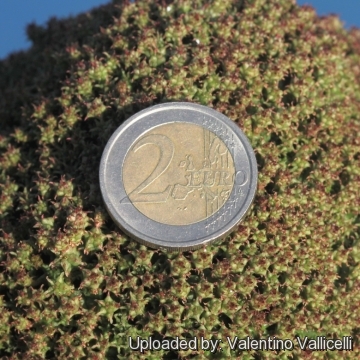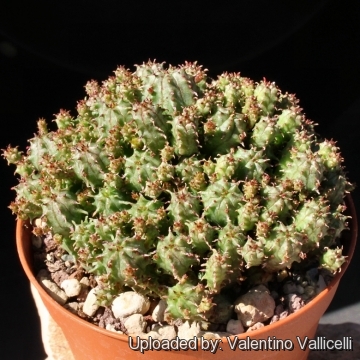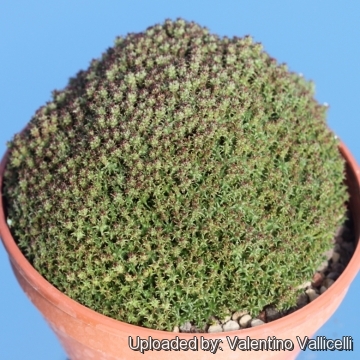
Euphorbia cv. Multiprolifera Photo by: Valentino Vallicelli
Origin and Habitat: Garden origin (Nursery produced cultivar)
Synonyms:
Description: Euphorbia cv. MultiproliferaSN|27727]]SN|25085]] is a beautiful cultivars, strong and easy to grow that will readily form large crowded clumps composed by thousands of tiny heads. It is very similar to Euphorbia submammillaris f. pfersdorfiiSN|25085]]SN|27727]] (if not the same and presumably of hybrid origin. It is however very difficult to identify the species involved in this cross and is hard to tell apart the exact ancestors only by body characteristics.
Stem: Very small 3 to 5 mm thick, fresh green turnig purplish in full sun.
Ribs: 5 usually wing-like, prominent.
Spines: It has only a nail-like, non pungent thorn 1 mm long at the tip of each tubercle usually purple quickly weathering to grey.
Flowers: Not seen.
 Euphorbia cv. Multiprolifera Photo by: Valentino Vallicelli
Euphorbia cv. Multiprolifera Photo by: Valentino Vallicelli Euphorbia cv. Multiprolifera Photo by: Valentino Vallicelli
Euphorbia cv. Multiprolifera Photo by: Valentino Vallicelli Euphorbia cv. Multiprolifera Photo by: Valentino Vallicelli
Euphorbia cv. Multiprolifera Photo by: Valentino VallicelliSend a photo of this plant.The gallery now contains thousands of pictures, however it is possible to do even more. We are, of course, seeking photos of species not yet shown in the gallery but not only that, we are also looking for better pictures than those already present.
Read More... Cultivation and Propagation: It is an easy to grow plant for pot culture.
Growth rate: It is a relatively rapidly growing species that will make large clumps whit hundreds or even thousands heads given the best conditions.
Soil: It grows well in a very draining mineral potting substrate, but it isn't picky about soil.
Repotting: Use pot with good drainage.
Watering: During the summer they enjoy average watering, but do not overwater (Rot prone), keep dry in winter.
Fertilization: Feed with a high potassium fertilizer in summer.
Hardiness: When dormant in winter, keep it totally dry at or around 4°C, even though it seems to tolerate light frosts well.
Exposure: They do need a lot of light to keep their compact growth-form. They get a rich purple tinge if grown in full sun, however some protection in light shade is recommended during the hottest hours in summer.
Uses: It is an excellent plant for container growing. It always looks good and stays small. It looks fine in a cold greenhouse and frame.
Warning: As with all other Euphorbias when a plant get damaged it exudes a thick white milky sap known as latex. This latex is poisonous, and may irritate skin. Pay extreme attention not to get any in your eyes or mouth.
Cultivated plants must be handled carefully.
Rot: Rot it is only a minor problem with Euphorbias if the plants are watered and “aired” correctly. If they are not, fungicides won't help all that much.
Propagation: It is propagated by cuttings (It branches enthusiastically, and offsets are readily available). If you remove an offset, remember to let it dry for some days, letting the wound heal (cuttings planted too soon easily rot before they can grow roots). Lay it on the soil and insert the stem end partially into the substrate. Try to keep the cutting somewhat upright so that the roots are able to grow downward. It is better to wash the cut to remove the latex.













